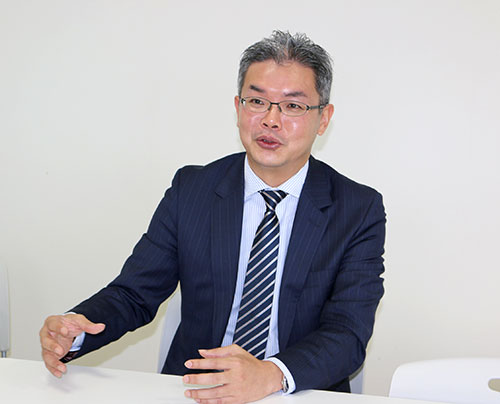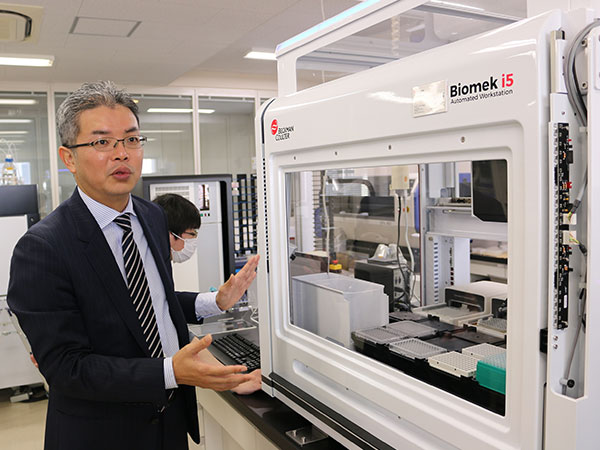
It is difficult to go even one day without hearing terms that are intended to promote efforts to protect the global environment such as carbon neutrality, SDGs (Sustainable Development Goals), and ESG (Environmental, Social, and Governance) management. To achieve the Japanese and other state governments' goal of balancing greenhouse gas (GHG) emissions by 2050, major technological breakthroughs are needed. Professor HASUNUMA Tomohisa (applied biochemistry, metabolic engineering), Director of the Engineering Biology Research Center, is a leading researcher in biotechnology. He uses genetically engineered "smart cells" of yeast, E. coli, and other bacteria to efficiently produce useful substitutes for petroleum and high value-added functional materials. We interviewed Professor HASUNUMA, who is working to construct a next-generation, cross-disciplinary biorefinery that integrates biotechnology and digital technology, about his progress in his cutting-edge research.
Started research in fermentation science
INTERVIEWER:
Professor HASUNUMA, you began as a researcher when you studied fermentation engineering at university. What was your motivation to major in fermentation engineering?
HASUNUMA:
I first became interested in biotechnology when my high school chemistry teacher stated that the age of biotechnology would come. Those words sparked my curiosity in biotechnology and I thought, "I want to study living organisms at the molecular level based on chemistry, and then apply the research results to practical applications." I entered the Department of Biotechnology, Graduate School of Engineering, Osaka University, which was the center of fermentation science in Japan, and then continued to the doctoral course. The origin of microbial biotechnology is the study of brewing and fermentation of sake, miso, soy sauce, and other fermentable products.
As a student of Osaka University and a researcher of the Research Institute of Innovative Technology for the Earth (RITE), I studied plant biotechnology for carbon dioxide (CO2) reduction and worked on topics related to CO2 reduction through vegetation expansion and material production. However, advances in research take a long time because higher plants have complex structures, which include roots, trunks, leaves, and other organs. Consistent with the change in RITE's research policy, I shifted my research focus to the cellular level with an emphasis on microorganisms, which are very simple.
INTERVIEWER:
Then you moved to Kobe University. Tell us more about that.
HASUNUMA:
When I started working at Kobe University in 2008, Professor FUKUDA Hideki, the former President of Kobe University and Professor KONDO Akihiko, the first Dean of the Graduate School of Science, Technology and Innovation, started an advanced fusion project called iBioK (Innovative BioProduction Kobe). With a grant of several billion yen over 11 years from the Japan Science and Technology Agency (JST), iBioK brought the best researchers in Japan to Kobe University to work on research and development of biorefinery. More than a dozen companies also participated. The project involved the construction of a value chain spanning the pretreatment of biomass, breeding of microorganisms, fermentation (material production), and separation and recovery of useful substances.
Highly efficient smart cell development through genetic manipulation

INTERVIEWER:
Will you please explain biorefinery?
HASUNUMA:
Biorefinery is an environmentally friendly technology that uses plants, which are sustainable resources, as raw materials to produce alternatives to fossil fuels and petrochemical products. The core of this technology is fermentation. Consequently, practical applications are difficult to achieve without improving the function of living organisms. In fact, in the 1990s, the realization of genome analysis technology to decipher entire genetic sequences of model organisms led to the so-called biotechnology boom. This boom attracted the attention of chemical and energy companies. Although bioproduction was attempted, this boom faded around 2000 because the organisms could not be controlled as expected and costs were high. Since then, advances in genome modification technology have made it possible to precisely control microorganisms. Additionally, the Paris Agreement signed in 2015 and the SDGs adopted by the United Nations have increased the global awareness of environmental issues. Under this context, expectations for the use of biotechnology in the bioeconomy and biomanufacturing have risen.
INTERVIEWER:
Can you tell us about the role of your research?
HASUNUMA:
Practical biorefineries will not be realized unless the production efficiency of useful substances by microorganisms is increased. Therefore, the Smart Cell Project, which aimed to develop microorganisms with a maximized substance production capacity, was implemented for 5 years starting in 2016. I participated as the R&D director. With funds totaling several billion yen from the New Energy and Industrial Technology Development Organization, a Japanese governmental R&D funding agency, the project united talented researchers across Japan, 16 universities, and 4 research institutes. Today, related research is ongoing and the technology is being developed.
Nowadays, it is not possible to survive the global R&D competition using only human power to manipulate, culture, and evaluate the production efficiency of genes of yeast, E. coli, etc. Advances in apparatuses that automate experiments have made it possible to develop smart cells more than ten times faster than manual work. At the end of 2021, we launched an autonomous experiment system called "Autonomous Lab" with Shimadzu Corporation. The Autonomous Lab integrates technologies and research results from different fields, including biotechnology, artificial intelligence (AI), and robotics. We call it "biofoundry" in an analogy to the foundries, which are semiconductor manufacturing plants. In Japan, Kobe University is the only university involved in such autonomous experimental efforts.
From international joint research to social implementation
INTERVIEWER:
The biofoundry project has been selected for Kobe University's own Fostering Joint International Research.* You will be working on joint research with universities in the United States, Germany, France, the United Kingdom, China, Singapore, Taiwan, South Africa, and other countries. Can you tell us more about this project?
HASUNUMA:
The lab covers broad research themes as many things have yet to be understood. For example, how do smart cells grow and respond to environmental stresses? It is important to collaborate with researchers around the world to absorb missing knowledge and bolster our research. Due to the global presence of Kobe University, leading researchers from around the world are motivated to work with us. We will pursue research outcomes that cannot be achieved by Japanese researchers alone through international joint research.
INTERVIEWER:
You have founded a university-originating startup company with the aim of practical applications of research results, namely social implementation. Tell us more about this company.
HASUNUMA:
Yes, I am a technical advisor to Bacchus Bio Innovation, which I started with the encouragement of management experts at the Graduate School of Science, Technology and Innovation, Kobe University. Early-stage research is carried out at the university, but when the path to commercialization becomes clear, the research is handed over to Bacchus. For example, once highly efficient smart cells have been developed at the laboratory level, Bacchus will cultivate these smart cells in large quantities and deploy them in companies engaged in industrial production. We hope to achieve "bio-first" production, in which microorganisms are used to create not only petrochemical products such as fuels and plastics, but also cosmetics, supplements, and various other substances.
Nurturing the next generation of researchers to become an international research center
INTERVIEWER:
With the biofoundry in a full-scale operation, research is expected to accelerate. What are some of your mid- to long-term goals?
HASUNUMA:
As a researcher, I would like to clarify the reaction mechanisms occurring in living cells and to accurately understand metabolic mechanisms and other processes at the molecular level. As an engineer, I would like to develop technologies that can be linked to actual manufacturing and share the results of my research with the world.
Most importantly, we need to train more researchers in this field. There are not enough researchers who are familiar with both biotechnology and digital technology. In addition, there are not enough biotech researchers interested in robotics. Not only would I like to foster young researchers in these cross-disciplinary fields, but also like for them to gain international experience and expand their personal networks with overseas researchers. Executive Vice President KONDO guided me personally and cultivated my skills. Now, I have built a network of contacts with a variety of people, including those overseas. I believe that it is important to share such experiences with the next generation. Since it is crucial to integrate a wide range of research, I would like Kobe University to become an international center where talented individuals can gather to create a unique network of individuals whom we have fostered.
*Note
Prof. HASUNUMA's projects have been approved as a Type B project and a Type C project under the Kobe University Strategic International Collaborative Research Grant program.






